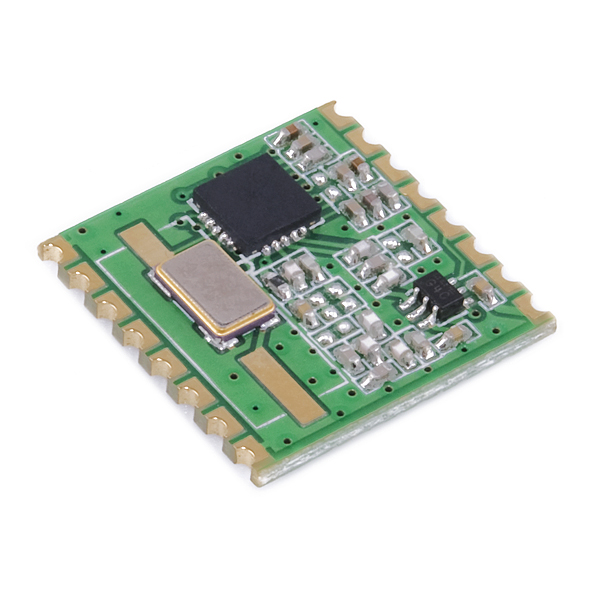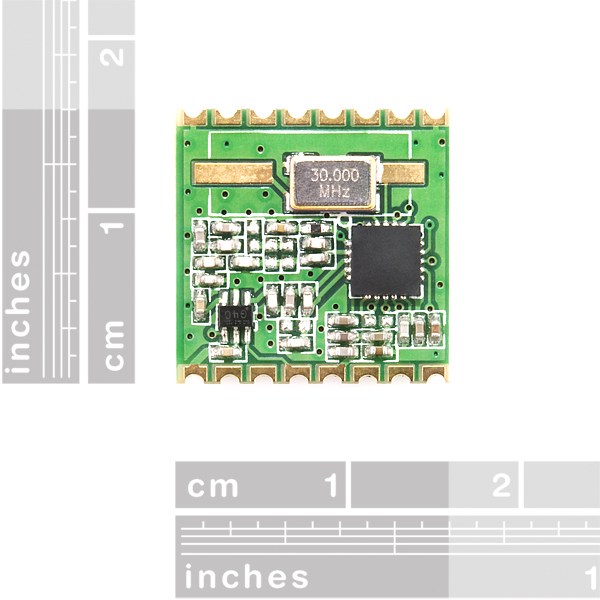RFM22-S2 SMD Wireless Transceiver
Replacement:WRL-10153. This has been replaced with the RFM22B. We will no longer be carrying this product and this page is for reference only.
The RFM22 is a low-cost ISM FSK transceiver module which offers communication at 434MHz and adjustable output power of up to +17 dBm. The wide operating voltage range of 1.8–3.6 V and low current consumption makes the RFM22 an ideal solution for battery powered applications.
Communication with the RFM22 is achieved via a standard 4-wire SPI interface. Three configurable general purpose I/Os are also available, the use of which can be tailored towards the needs of your project. A host of other features are also available including an 8-bit ADC, temperature sensor, RX and TX FIFOs, and low-battery detection. See the datasheet below for a complete description of every register and command.
The module comes in a 16-pin, 16 x 16mm, SMD package, with pins spaced by 2mm. Look for a breakout board coming soon!
Note: We found these in inventory and they work fine but we're no longer stocking them. We'll be selling them at a discount for a limited time but when they're gone, they're gone!
- Frequency Range = 434 MHz
- Sensitivity = -118 dBm
- +17 dBm Max Output Power (Configurable)
- Low Power Consumption
- Data Rate = 1 to 128 kbps
- Power Supply = 1.8 to 3.6 V
- Ultra low power shutdown mode
- Digital RSSI
- Wake-on-radio
- Auto-frequency calibration (AFC)
- Configurable packet structure
- Preamble detector
- TX and RX 64 byte FIFOs
- Low battery detector
- Temperature sensor and 8-bit ADC
- -40 to +85 °C temperature range
- Integrated voltage regulators
- Frequency hopping capability
- FSK, GFSK, and OOK modulation
- Low BOM
- Power-on-reset (POR)
- 16 x 16mm (0.63 x 0.63 in)
- Datasheet
- Hope RF's RFM22 Product Page
- Example Code (ATmega328)
Comments
Looking for answers to technical questions?
We welcome your comments and suggestions below. However, if you are looking for solutions to technical questions please see our Technical Assistance page.
Customer Reviews
No reviews yet.




Hi,
Is there a driver for microchip pic18f family ?
Is th module for sale using the first run of silicon? Looking at p.146 of the provided datasheet, the "errata" section (19 separate issues) seems to show most of the functionality of this chip does not work as intended, or does not work at all. Item 11: wakeup timer does not work at all, is listed as a "minor" problem.
the example code works only with arduino or can I make it work with avr studio?
The example code as is will only work with arduino, but can easily be converted to work in avr studio.
I just bought one of these and completely forgot about aerials... does anyone know of a suitable chip antennae?
I found two: go to farnell and search for "433mhz ceramic antenna".
Can anybody who bought this board tell me what Frequency band the transceiver is tuned to and what version Si4432 is on the board , I.e. V2,A1 or B1
Thanks
gary
Pretty sure they're V2. Register 0x01 returns 2 on the units I have.
Anyone have ideas of typical battery life?
Ahh, this has proper Digital RSSI which the RFM12B don't have.
With this it is possible to make an cheap Logic Analyzer for 430-440Mhz Ham radio band...
Crap, I meant Spectrum Analyzer, not Logic Analyzer...
Was a little tired when i made that post, doh.
Any Idea what range can be squeezed from this item
Direct LOS you can get 500-800m with ease on low bit rate, assuming you really implement error detection to discard wrong packets. Using directional antenna you can go up to 2km LOS.
I'd love to know what settings / code you used to get this sort of range. With the SparkFun example code above I get ~30m. I can extend it a little by lowing the data rate right down but it's still nowhere near 800m.
This thing looks similar to a CC1101 IC from TI. Similar Low BOM count and cost, but with a few more configuration options available, including FEC(Forward Error Correction), a higher Data rate, Larger FIFO's, and one more modulation type.
The CC1101 is also a little bit more complicated to configure, but has few more options for those who might need it!
In my experience chipcon (now TI) CC10xx chips are much harder to configure / tune and expensive than Sylabs chip.
On the other hand, TI has better software support and more app notes, etc, available.
It appers that there may be 4 models (frequency bands) of this module available. From the product pictures, it looks like this is a 434 MHz model. Is this true and if I order this SKU will I always get a 434 MHz model?
That is correct. The Sylabs chip embedded can deal with full band, but the tuning circuit is separated in 4 different frequency bands, I am not sure why Sparkfun describe it as full band support.
I'm having trouble locating the band restriction on the RFM22.
From the datasheet and from what I've read at the manufacturer's
site, this module offers "continuous frequency tuning over the complete 240?930 MHz band".
I'm looking for an inexpensive way to communicate with one of TI's
915MHz Chronos watches, and this seemed, at first glance, to be
a good route. What are you all seeing that I'm missing?
Or has something changed since February?